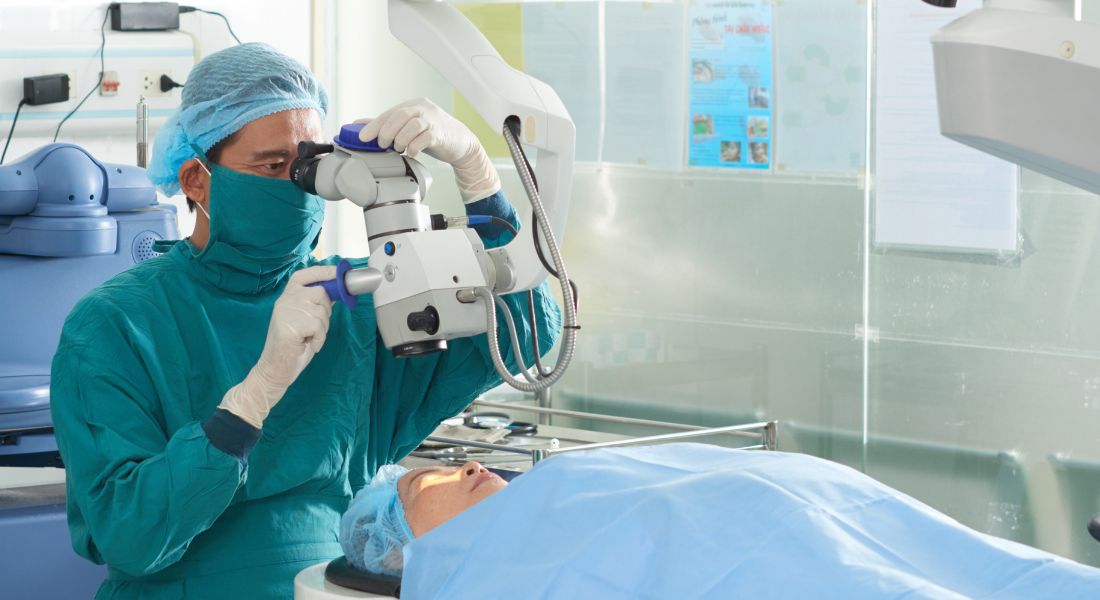How Much Does LASEK Surgery Cost? Transparent Guide

If you’re thinking about getting LASEK surgery, one of the first questions that probably comes to mind is: How much does it actually cost? And it’s a fair question. Laser eye surgery isn’t a small purchase, and if you’re exploring your options, you deserve clear, transparent and realistic information before making a final decision.
The problem is that the cost of LASEK can feel confusing. You’ll see clinics offering bargain prices, premium packages, dramatic discounts, “from £X” offers, and add-on fees that may (or may not) apply to you. You may also have noticed that some clinics aren’t very open about the full cost upfront, which makes everything feel even more overwhelming.
That’s exactly why I created this guide. I want you to understand the real cost of LASEK, why prices vary so much, what’s actually included, what you should look out for, and how this investment compares to wearing glasses or contact lenses long-term. My goal is to equip you with clear, honest information so you can make the best financial and medical decision for your eyes.
By the end of this article, you’ll know the typical price range in the UK, what factors influence the cost, and how to evaluate whether a clinic is offering genuine value not just a clever marketing price tag.
What Is the Typical Cost of LASEK in the UK?

Before diving into the details, here is a realistic overview of what most people pay for LASEK in the UK.
Average UK Cost for LASEK:
£1,500–£2,500 per eye or £3,000–£4,500 for both eyes
There are clinics that charge less, and clinics that charge more, but most reputable providers fall into the range above.
If you see prices that seem dramatically cheaper like “£595 per eye” or “half-price LASEK” approach with caution. Often these figures:
- apply only to very low prescriptions
- exclude aftercare or enhancements
- use older technology
- require paying extra for the treatment you actually need
On the other hand, higher-tier clinics charging £2,000+ per eye tend to offer:
- the latest technology
- surgeons with 15–25+ years’ experience
- advanced diagnostic testing
- safer protocols
- longer aftercare and follow-up
- more predictable outcomes
Price differences almost always reflect the clinic’s level of expertise, technology, and support not just the laser session itself.
Why LASEK Costs What It Does
Many people assume the cost is based purely on the time the surgeon spends with you, but LASEK pricing reflects much more than the procedure. When you pay for LASEK, you’re paying for:
- the surgeon’s expertise
- the clinical team
- premium diagnostic equipment
- extremely precise technology
- surgical safety systems
- aftercare appointments
- follow-up scans
- enhancements or adjustments if needed
Let’s break down the factors that influence the cost so you understand exactly what you’re paying for.
The Surgeon’s Experience Level
Surgeons with extensive experience especially those who have performed tens of thousands of procedures usually charge more. And it makes sense. With your eyes, expertise matters more than anything else.
A highly experienced surgeon brings:
- better judgement
- more consistent results
- fewer complications
- refined planning
- years of managing complex cases
Cheaper clinics often rely on:
- rotating surgeons
- junior surgeons
- part-time surgeons
You’re not just paying for someone to operate a laser; you’re paying for someone to operate on your vision. Experience is worth every penny.
Technology and Equipment Used
Not all laser systems are equal. Clinics with the newest generation lasers typically offer:
- higher accuracy
- gentler surface ablation
- smoother healing
- fewer complications
- more predictable results
Older systems, usually found in low-cost centres, may cost less to operate but often deliver:
- more discomfort
- longer recovery
- less precise results
Premium technology not only improves outcomes but also reduces the risk of needing an enhancement later.
Diagnostic Testing and Scans
Before LASEK, you’ll undergo several tests to ensure your eyes are safe for treatment, such as:
- corneal topography
- corneal tomography
- epithelial mapping
- dry eye assessments
- pupil measurements
- tear film stability
- prescription stability tests
High-end clinics invest in advanced imaging systems like Pentacam, MS-39, and wavefront analysers. These provide highly detailed maps of your cornea’s shape, thickness, and optical quality. Cheaper clinics often skip some of these tests or use older machinery. Comprehensive testing costs more but dramatically improves safety.
Personalisation of Treatment
Some clinics offer “one-size-fits-all” LASEK.
Others tailor each treatment based on:
- corneal thickness
- tear film
- optical aberrations
- individual prescription
- visual lifestyle
Customised treatments require:
- more time
- better diagnostics
- more advanced lasers
- surgeon analysis
This usually costs more but it delivers a better, safer, more natural visual outcome.
Whether Aftercare Is Included
Aftercare appointments often include:
- prescription checks
- corneal healing reviews
- dry eye assessments
- topography scans
- access to your surgeon
Premium clinics include this in the cost.
Budget clinics sometimes charge extra for:
- follow-up visits
- extra scans
- urgent reviews
A good rule is: Never choose a clinic that charges “per appointment” for aftercare.
Enhancement or Refinement Procedures
Sometimes, a patient may need a small enhancement months or years later. Many high-quality clinics include this for free or at a reduced cost when they believe it’s medically appropriate.
Budget clinics may charge for:
- re-treatments
- new scans
- new prescriptions
- separate consultations
Enhancement policies significantly affect long-term cost.
Prescription Complexity
Price may vary based on:
- whether you have astigmatism
- the level of your prescription
- the smoothness of your corneal surface
- your eye’s biomechanical stability
High prescriptions require:
- more laser time
- more analysis
- more expertise
So, the cost may be slightly higher.
Whether You Choose One or Both Eyes
Most people choose to treat both eyes simultaneously, which results in better visual symmetry and often a lower per-eye cost.
Single-eye treatment can be slightly more expensive in proportion because fixed clinic costs (equipment, staff, diagnostics) remain the same.
The Location of the Clinic
Clinics in major cities especially central London typically charge more due to:
- staff expertise
- higher operational costs
- premium equipment
- demand
- access to senior surgeons
But you’re also more likely to find highly specialised surgeons in these locations.
The Level of Patient Support
Comprehensive, personalised patient support requires:
- trained staff
- longer appointment times
- ongoing communication
- emergency availability
These all add to the cost but also ensure better outcomes and a more positive experience.
Cost Breakdown: What You’re Actually Paying For

To help you understand exactly where your money goes, here’s a typical breakdown of LASEK costs:
20–30% Surgeon Fees: Expertise, planning, procedure skill, follow-up reviews.
20–25% Diagnostic Equipment + Pre-Op Tests: Advanced scanning machines and clinical testing.
25–35% Laser Technology + Theatre Resources: Maintenance, upgrades, consumables, safety systems.
10–15% Aftercare + Follow-Up Scans: Topography checks, healing reviews, surgeon consultations.
5–10% Administration + Patient Support: Coordination, patient care, communications.
Understanding this breakdown shows you that the cost reflects a complete medical process not just a single treatment day.
What’s Included in a Good LASEK Package?
A reputable clinic will include:
- initial consultation
- all diagnostic scans
- personalised treatment plan
- LASEK surgery
- bandage contact lenses
- postoperative medications
- aftercare appointments (usually 12–18 months)
- emergency access
- refinement/enhancement if needed
- all follow-up scans
If a clinic charges extra for anything above, ask why.
What’s NOT Included in Cheaper Packages?
Budget clinics often exclude:
- high prescription treatments
- astigmatism corrections
- advanced scanning
- custom planning
- topography-guided treatment
- postoperative medication
- same-surgeon aftercare
- refinement procedures
Cheaper prices may look appealing, but you may end up paying more in add-ons or compromising your safety.
Comparing LASEK vs LASIK Costs
LASEK is often slightly cheaper because:
- it uses surface ablation
- no flap creation is needed
- equipment costs are lower
However, the difference is typically small.
Most clinics charge:
- LASIK: £3,500–£7,000 for both eyes
- LASEK: £2,500–£6,500 for both eyes
Price shouldn’t be the main factor when deciding between them. Your eye’s anatomy and suitability matter far more.
LASEK vs Contact Lenses: Long-Term Cost Comparison
Contact lenses seem cheap initially, but long-term, they add up quickly.
Average cost of contact lenses per year: £250–£400
Over 10 years: £2,500–£4,000
Over 20 years: £5,000–£8,000
Plus, there are indirect costs:
- solution
- check-ups
- dry eye treatments
- replacements
- lost lenses
LASEK is a one-time cost that often works out cheaper long-term.
LASEK vs Glasses: Long-Term Value

Glasses are becoming more expensive due to:
- premium lenses
- blue-light coatings
- anti-glare coatings
- thin lenses for high prescriptions
- designer frames
Many people spend £300–£500 every 1–2 years.
Over 20 years, that could be: £3,000–£10,000
LASEK eliminates most of these costs.
When Paying More for LASEK Is Worth It
You should strongly consider a higher-priced clinic if:
- you want the most experienced surgeon
- you value a calm, personalised experience
- you have a complex prescription
- you want top-tier diagnostic testing
- you prefer the safest possible treatment
- you want long-term support and aftercare
Laser eye surgery is not the time to shop for a bargain.
Vision is too important.
When a Lower Price Might Be Fine
A cheaper clinic might be acceptable if:
- you have a low, simple prescription
- you understand what’s included vs not included
- safety standards are clearly explained
- you feel confident with the surgeon
But always research thoroughly.
Is LASEK Worth the Investment?
Most patients say yes, and many wish they had done it earlier.
Here’s why:
- permanent freedom from glasses
- confidence during sports and holidays
- no more fogged glasses
- clearer, wider field of vision
- safer vision for driving
- better long-term eye comfort
- fewer dry eye issues compared to contacts
People describe it as “one of the best decisions of my life”, not just a medical treatment.
FAQs:
- Is LASEK more expensive than LASIK?
LASEK is usually slightly cheaper than LASIK because it doesn’t require creating a corneal flap, which reduces the equipment and consumable costs for the clinic. Although the difference in price is often modest, LASEK can be more cost-effective for patients with thinner corneas or those who are not suited to LASIK. However, the final price depends on the clinic’s technology, the surgeon’s expertise, and the level of aftercare offered. In some premium clinics, both procedures may cost almost the same because the fee includes advanced diagnostics and personalised treatment planning. - Why do LASEK prices vary so much between clinics?
Prices differ mainly due to technology, surgeon experience, and aftercare quality. Some clinics invest heavily in modern laser platforms, advanced imaging systems, and highly trained teams, which increases the overall cost but also improves safety and accuracy. Others operate with older equipment, limited testing, or less experienced surgeons, which lowers the price but may reduce the quality of the experience. Marketing promotions, location, and the inclusion or exclusion of aftercare also influence the final cost you’re quoted. - Does the price include aftercare appointments?
In reputable clinics, the fee almost always includes all postoperative appointments, typically covering 12 to 18 months of reviews. These visits are essential for ensuring stable vision, correct healing, and early identification of any concerns. Some budget clinics offer a lower upfront price but charge separately for follow-up visits, scans, and emergency reviews. This can make the seemingly cheap option far more expensive in the long run, so it is important to confirm exactly what your package includes. - Are enhancement procedures included in the cost?
Many high-quality clinics include enhancements when they believe it is medically appropriate. This is particularly valuable because a small percentage of patients may need a refinement month or even years later to achieve the sharpest possible vision. Low-cost centres often charge extra for enhancements, requiring new consultations, scans, and additional treatment fees. This difference alone can significantly affect the lifetime value of your investment. - Is there a separate cost for treating astigmatism?
Some clinics charge more for treating astigmatism, especially if it requires extra laser time or customised planning. Others include astigmatism correction as part of their standard LASEK fee. Astigmatism often requires more precise measurements and tailored treatment maps, which can increase the overall cost if the clinic uses advanced diagnostic equipment. Before booking, it’s wise to ask whether the quoted price already covers astigmatism correction. - Why are London clinics usually more expensive?
Clinics in central London generally charge higher fees due to increased operational costs, access to senior surgeons, and investment in state-of-the-art technology. These clinics commonly attract patients who prioritise expertise, safety, and comprehensive care. Although treatment may be more expensive than in smaller towns, many patients feel the additional cost is justified because the outcomes and patient support are often more consistent and reliable. - Does insurance cover LASEK in the UK?
Most private insurance policies classify LASEK as an elective treatment and do not cover the cost. Some premium insurance plans may pay for part of the pre-operative testing if it relates to diagnosing an underlying eye condition, but this is rare. However, a few NHS-related schemes sometimes assist people whose vision cannot be corrected with glasses or contacts, although this applies to extremely limited medical circumstances. For most people, LASEK is a self-funded procedure. - Is it worth paying more for a highly experienced surgeon?
For many patients, the answer is yes. A surgeon with decades of experience, tens of thousands of procedures, and extensive knowledge of complex cases can dramatically improve safety and predictability. Their judgement during planning, ability to manage unusual corneal shapes, and understanding of long-term stability all contribute to better outcomes. While less experienced surgeons can also be competent, the reassurance of knowing your vision is in the hands of a seasoned specialist is often well worth the additional cost. - Are extremely cheap LASEK deals safe?
Cheap deals aren’t automatically unsafe, but they often involve compromises. These may include older laser technology, limited diagnostic testing, add-on costs for essential services, or aftercare delivered by staff rather than the surgeon. Marketing offers such as “£595 per eye” often apply only to a small number of patients with very simple prescriptions. In some cases, the low starting price increases dramatically once the necessary add-ons are included. The most important step is to understand exactly what you are paying for rather than choosing based on headline prices. - How can I tell whether a LASEK package offers good value?
Good value isn’t about the lowest price but the balance of quality, safety, support, and long-term outcomes. A package is worthwhile when it includes full diagnostic testing, surgeon-led consultations, modern laser technology, comprehensive aftercare, emergency access, and enhancements if needed. You should also feel confident in the surgeon’s experience and the clinic’s transparency about costs. If the clinic is open about what’s included, uses advanced equipment, and offers long-term care without hidden fees, the overall value is usually strong.
Final Thought: LASEK Surgery Costs
Understanding the real cost of LASEK surgery is essential when you’re making a long-term investment in your vision. While prices vary widely between clinics, those differences usually reflect the technology used, the surgeon’s experience, the level of diagnostic testing, and the quality of aftercare you receive. When you compare these factors alongside the long-term costs of glasses or contact lenses, LASEK often becomes a more cost-effective and convenient solution.
The key is to choose a clinic that is transparent, uses the latest equipment, and gives you the confidence that your eyes are in safe, experienced hands. With the right guidance and support, LASEK can offer not just clearer vision but also long-lasting value. If you’re exploring whether Lasek surgery in London could benefit you, get in touch with us at Eye Clinic London to schedule your consultation and discuss your options in detail.
References:
- Cagini, C., Fiore, T., Piccinelli, F. & Fruttini, D. (2021), Surface Ablation (PRK and TransPRK): Current Perspectives, Journal of Clinical Medicine, 10(20), 4727. https://www.mdpi.com/2077-0383/10/20/4727
- Lohmann, C.P. & Reischl, V. (2020), Advances in Surface Laser Ablation Techniques, Applied Sciences, 10(22), 8161. https://www.mdpi.com/2076-3417/10/22/8161
- Shortt, A.J., Allan, B.D. & Evans, J.R. (2013), Laser-assisted subepithelial keratectomy (LASEK) for myopia, Cochrane Database of Systematic Reviews, (1):CD009799. https://pubmed.ncbi.nlm.nih.gov/23450598/
- Lee, H.K. et al. (2001), Comparison of LASEK and PRK for the correction of myopia, Journal of Cataract & Refractive Surgery, 27(4), pp.565–570. https://pubmed.ncbi.nlm.nih.gov/11311617/
- Camellin, M. (2004), LASEK technique: laser epithelial keratomileusis, Eye & Contact Lens, 30(1), pp.21–25. https://www.ncbi.nlm.nih.gov/pmc/articles/PMC1358887/

